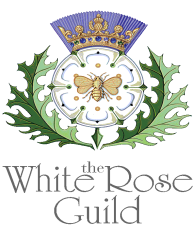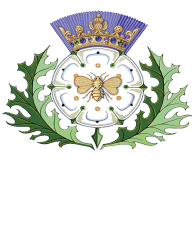John Sadler BA (Hons), M.Phil, FRHistS, FSA (Scotland.)
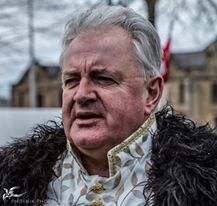 One of the most notable historians of Anglo-Scottish Border conflicts, John Sadler has published a number of books on the subject and is also a successful lecturer, heritage consultant, historical interpreter and battlefield tour guide. ‘From an early age I have been obsessed with the highlands and borders.’ he says, ‘Since then I have travelled, walked, ridden and driven over most of the ground and looked at every battlefield, hillfort, broch, dun and castle.’
One of the most notable historians of Anglo-Scottish Border conflicts, John Sadler has published a number of books on the subject and is also a successful lecturer, heritage consultant, historical interpreter and battlefield tour guide. ‘From an early age I have been obsessed with the highlands and borders.’ he says, ‘Since then I have travelled, walked, ridden and driven over most of the ground and looked at every battlefield, hillfort, broch, dun and castle.’
Sadler regularly lectures at The National Army Museum, Imperial war Museum, RMA Sandhurst, Heriot Watt University, Society of Antiquaries of Newcastle upon Tyne, The Literary and Philosophical Society, Newcastle, Durham University, the DLI Museum & Art Gallery and contributes to many military and historical journals as well. He is a Fellow of the Royal Historical Society, a Fellow of Scotland’s Society of Antiquaries, a graduate Holocaust Fellow of the Imperial War Museum and a member of Equity.
First in the Attack
In the bloody aftermath of the ‘Forty-five and its terrible denouement at Culloden, the Tory clans were viewed as the enemy, the enemies of the Hanoverian state and were treated barbarously on account of it.
![]() Yet, after a decade as Britain embarked on what he been described as the First Global conflict – the Seven Years War (1756- 1763), itself a part of the wider ‘Second Hundred Years War’ between Britain and France, Pitt the Elder needing troops to fight on so many fronts, in the Old World and the New, in India and the Philippines, realised that these very same highlanders wearing red-coats could be of considerable service to the crown and they were. Fighting in the dense, natural terrain of North America and Canada they proved more adaptable and with far better fieldcraft than their English comrades. Clan loyalties transferred very easily on to clan regiments and though they’d be tested to the limits, they came through with flying colours. Few tests could have been more challenging than the ill-judged attack on Fort Ticonderoga’.
Yet, after a decade as Britain embarked on what he been described as the First Global conflict – the Seven Years War (1756- 1763), itself a part of the wider ‘Second Hundred Years War’ between Britain and France, Pitt the Elder needing troops to fight on so many fronts, in the Old World and the New, in India and the Philippines, realised that these very same highlanders wearing red-coats could be of considerable service to the crown and they were. Fighting in the dense, natural terrain of North America and Canada they proved more adaptable and with far better fieldcraft than their English comrades. Clan loyalties transferred very easily on to clan regiments and though they’d be tested to the limits, they came through with flying colours. Few tests could have been more challenging than the ill-judged attack on Fort Ticonderoga’.
Duncan Campbell was one of those who took part in the disastrous attack ordered by General James Abercrombie against the defences of Fort Carillon in July 1758. This was one of the many actions fought in the course of the Seven Years War (1756 – 1763) in the vast arena of the North American wilderness. Ten days after the fight, Duncan Campbell, serving with the 42nd succumbed to his wounds. Some three years beforehand Campbell is said to have provided shelter to one who turned out to have been his brother’s murderer.
![]() This was a fine choice for a highland gentleman; to deny the call of vengeance or the obligations of the host. A humane man, he spared the assassin and gave him refuge. A little while after his dead brother appeared to him in a dream in which he promised they would meet again at a place called Ticonderoga, which at that point and, unsurprisingly, Campbell had never heard of. On the very afternoon of the day on which the fateful engagement had been played out in New York State, a ghostly panoply of fighting men appeared in the clouds over Inveraray Castle, Clan Campbell was thus given notice it would soon mourn many of its lost sons.
This was a fine choice for a highland gentleman; to deny the call of vengeance or the obligations of the host. A humane man, he spared the assassin and gave him refuge. A little while after his dead brother appeared to him in a dream in which he promised they would meet again at a place called Ticonderoga, which at that point and, unsurprisingly, Campbell had never heard of. On the very afternoon of the day on which the fateful engagement had been played out in New York State, a ghostly panoply of fighting men appeared in the clouds over Inveraray Castle, Clan Campbell was thus given notice it would soon mourn many of its lost sons.
The name Ticonderoga derives from the Iroquois expression tekontaro:ken – ‘at the junction of two waterways’, an entirely pragmatic description for the place stands astride the strategically significant narrow passage of Lake Champlain, where a short traverse cuts through to the northern flank of Lake George. Thus the fort dominated the busy trade highway between English-held Lake Hudson and the French-controlled St. Lawrence River. Such was the importance of its location that four major combats were fought out there within a mere two decades.
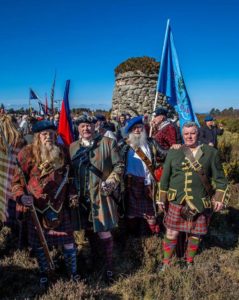 When the French began to build in 1755, they named their new work Fort Carillon, the choice inspired by the almost musical resonance of tumbling falls nearby. Construction was spread over a period of two years and the ramparts were not completed until 1757. By then local rivalry between France and England had flared as a wider consequence of the Seven Years War, Pitt the Elder’s expansionist triumph that a later populist leader, Winston Churchill, branded as ‘The First World War’. It was from there the French launched a successful campaign against Fort William Henry, an episode familiar to all readers of James Fenimore Cooper’s Last of the Mohicans.
When the French began to build in 1755, they named their new work Fort Carillon, the choice inspired by the almost musical resonance of tumbling falls nearby. Construction was spread over a period of two years and the ramparts were not completed until 1757. By then local rivalry between France and England had flared as a wider consequence of the Seven Years War, Pitt the Elder’s expansionist triumph that a later populist leader, Winston Churchill, branded as ‘The First World War’. It was from there the French launched a successful campaign against Fort William Henry, an episode familiar to all readers of James Fenimore Cooper’s Last of the Mohicans.
By the following year the British in North America had been substantially reinforced whilst the French under Louis-Joseph de Montcalm, were forced back onto the defensive. Two campaigns were planned, General Amherst would lead an attempt on the great French bastion of Louisbourg, whilst Abercrombie, as C-in-C would assault Fort Carillon. His forces were considerable, comprising some 7,000 British redcoats and 9,000 colonial militia; well supported by a formidable artillery train. His regular battalions included the 27th, 44th, 46th, 55th and the 42nd Highland regiment (The Black Watch). For the difficult and dangerous business of scouting and skirmishing he could count upon over a thousand of light infantry. Col. Gage, commanding the 80th foot, was a devoted student of that celebrated exponent of irregular warfare Richard Rogers, whose Rangers had already made a name for themselves as masters of commando style operations.
![]() Against this formidable deployment Montcalm could muster no more than 3,600 defenders all told, made up of seven battalions of French regulars, supported by marines, French colonials and native allies. He knew the blow must fall upon the bastion of Ticonderoga and thus looked to his defences. The site enjoyed a superb tactical position, pushed out on a spur that jutted, like a salient against the course of the river, the rushing waters providing additional cover on three sides. The fourth flank was partly screened by a bog and covered by a timber outwork, a substantial palisade nine feet high, the timbers soundly buttressed, and the ground before sown with stakes and other obstacles. The fort itself was a classic star shaped construction with four corner strengths or bastions, two freestanding works, or ravelins, guarding the most exposed flanks and the whole built upon a swell of higher ground, it was altogether a most commanding position.
Against this formidable deployment Montcalm could muster no more than 3,600 defenders all told, made up of seven battalions of French regulars, supported by marines, French colonials and native allies. He knew the blow must fall upon the bastion of Ticonderoga and thus looked to his defences. The site enjoyed a superb tactical position, pushed out on a spur that jutted, like a salient against the course of the river, the rushing waters providing additional cover on three sides. The fourth flank was partly screened by a bog and covered by a timber outwork, a substantial palisade nine feet high, the timbers soundly buttressed, and the ground before sown with stakes and other obstacles. The fort itself was a classic star shaped construction with four corner strengths or bastions, two freestanding works, or ravelins, guarding the most exposed flanks and the whole built upon a swell of higher ground, it was altogether a most commanding position.
Any successful assault could only be prepared after the major logistical effort needed to transport, men, their equipment and supplies, the great guns, ammunition and quantities of powder had been competently undertaken. The officer responsible was Brigadier Viscount George Augustus Howe, one of several remarkable brothers, all of whom were destined to leave their mark on North America. Howe, colonel of the 55th had made a particular study of the irregular pattern of warfare that so suited the terrain and had spent time with Rogers. The many lessons learnt he put to good effect, stripping his fellow officers of much of their more luxurious baggage, lightening the men’s load, adapting their uniform, weapons and drill. He went so far as to be seen washing his own linen in rivers, a chore normally undertaken for officers by the regimental women whom he’d sent back, this was indeed novel!
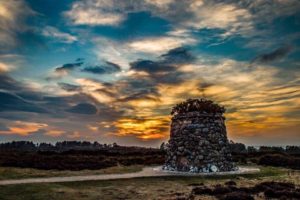 In the warm flush of a continental summer, the end of June, Abercrombie’s task force was mustering on the banks of Lake George, the ruins of Fort William Henry a potent reminder. Thanks to Howe’s efficiency some 800 barges or bateaux, plus 90 whaleboats had been laboriously hauled overland, each of the boats would carry 22 troops with all their gear and 30 days supply of foodstuffs. On 5th July with commendable discipline and élan the regiments embarked and the great flotilla of heavily laden craft proceeded sedately down the length of Lake George. It was indeed a sight of awesome majesty, the might of the burgeoning British Empire, a rich tableau of scarlet and gold, the deep blue of the colonials, the latent power of the great guns, lashed to rafts, the silken standards lifting in a gentle breeze. Around them the sylvan glories of an untouched wilderness; tall stands of pine and fir, the light glancing from the calm, burnished waters of the lake, hills rising on every side.
In the warm flush of a continental summer, the end of June, Abercrombie’s task force was mustering on the banks of Lake George, the ruins of Fort William Henry a potent reminder. Thanks to Howe’s efficiency some 800 barges or bateaux, plus 90 whaleboats had been laboriously hauled overland, each of the boats would carry 22 troops with all their gear and 30 days supply of foodstuffs. On 5th July with commendable discipline and élan the regiments embarked and the great flotilla of heavily laden craft proceeded sedately down the length of Lake George. It was indeed a sight of awesome majesty, the might of the burgeoning British Empire, a rich tableau of scarlet and gold, the deep blue of the colonials, the latent power of the great guns, lashed to rafts, the silken standards lifting in a gentle breeze. Around them the sylvan glories of an untouched wilderness; tall stands of pine and fir, the light glancing from the calm, burnished waters of the lake, hills rising on every side.
By dawn the following day, 6th July, the long passage of Lake George had been accomplished without mishap and the battalions were approaching the narrows; ahead of them was the expanse of Lake Champlain but, rising in its headland, reared the great mass of Fort Ticonderoga, an unconquered citadel. Montcalm, however outnumbered, was still vigilant and the shoreline was held by a commanded body of skirmishers; fire from the boats drove these back beneath the shelter of the trees and the attackers disembarked without further opposition. Once ashore, the men were detailed into marching columns but this terrain was not the level arena of Flanders, it was rather a dense web of tangled undergrowth, fallen trees and confusing slopes. Abercrombie’s guides proved less than competent and the British were soon in difficulties. In the confusion the right, commanded by Howe, became involved in a running fight with the French, taking casualties, amongst these was their gallant commander, one whose loss would be keenly felt. Major-General Stewart writing of the action some decades after, commented:
The march was continued in the same order [July 7th], but the ground not having been previously examined, and the guides proving extremely ignorant, the columns came in contact, and were thrown in confusion. A detachment of the enemy, which got bewildered in the wood, fell in with the right column, at the head of which was lord Howe. A smart skirmish ensued, in which the enemy were driven back and scattered with considerable loss. This petty advantage was dearly purchased by the death of Lord Howe.
Abercrombie, deprived of his subordinate’s wise counsel, now took a fateful and disastrous decision. Sensibly, he could have deployed his colonials to interdict communications between the beleaguered fort and possible reinforcement from Fort St. Frederic (Crown Point). He could then have begun the laborious process of dragging the guns from their barges to the eminence of Mount Defiance and, from there commenced a bombardment, which given the weight of shot he disposed must surely have soon battered the fort into submission. He chose instead to rely on the distinctly unsound advice of a junior officer of engineers, who opined the impromptu works covering the approach were flimsy and could be rushed with the bayonet. With drums beating and banners unfurled the regular battalions of foot moved into the attack with purpose and precision, but the defences were far stronger than had been suggested, the line of the breastwork was held by Montcalm’s veterans.
A withering hail of fire greeting the leading ranks who were flensed away as their comrades behind struggled to fight through the lines of obstacles – this was grim, close quarter work, which presaged the horror of the trenches; the men could make no headway:
Masses of infuriated men could not go forward and would not go back; straining for an enemy they could not reach, and firing on an enemy they could not see, they were caught in the entanglement of felled trees. Shooting, yelling and cursing, they were assailed all the while with bullets, which killed them by scores, stretched them on the ground, or hung them on jagged branches, in strange attitudes of death.
Thus far the 42nd, with the 55th had been kept in reserve but, as the assault faltered, they were now sent in. Formed nearly two decades beforehand the 42nd (Lord John Murray’s Highlanders – the Black Watch) were proud of their natural elitism – drawn mainly from the ranks of Clan Campbell, the soldiers were men of quality and some standing. Their élan was ferocious and they fell upon the defences with gusto. The battle now reached its savage denouement as the highlanders fought and clawed their way forward, Captain John Campbell and a handful of his company became the only British forces to gain a lodgment in the enemy position but, unsupported and disdaining retreat, they were cut down to a man. As the celebrated historian Francis Parkman wrote:
Then the highland soldiers of the 42nd could endure no longer. Impatient of their position in the rear, they rushed forward, hewed their way through the obstacles with their broadswords. Since no ladders had been provided, they made strenuous efforts to carry the breastworks, partly by mounting on each other’s shoulders and partly by fixing their feet in holes, which they had excavated with their swords and bayonets in the face of the work. The defenders were so well prepared that the instant an assailant reached the top, that instant he was thrown or shot down.
Losses were frightful, the 42nd, which had suffered most grievously, had lost eight officers, nine NCO’s and 297 other ranks killed, 17 officers, ten NCO’s and 306 men hurt – a total loss of 647, the regiment was reduced to a mere shell. The attack was a disastrous failure though, in recognition of its sacrifice the 42nd was awarded by George II with the designation ‘Royal’ – never was such a distinction better merited.
